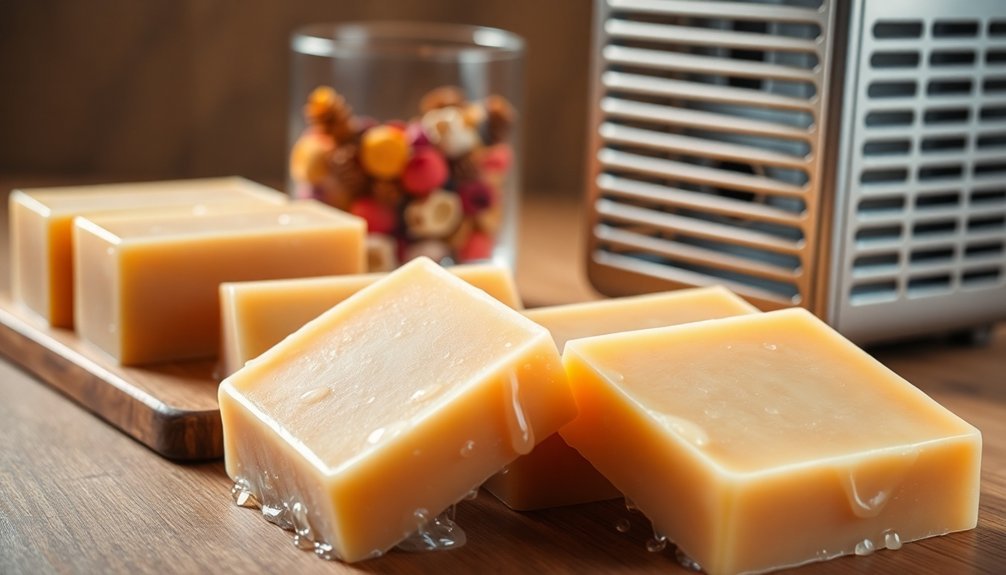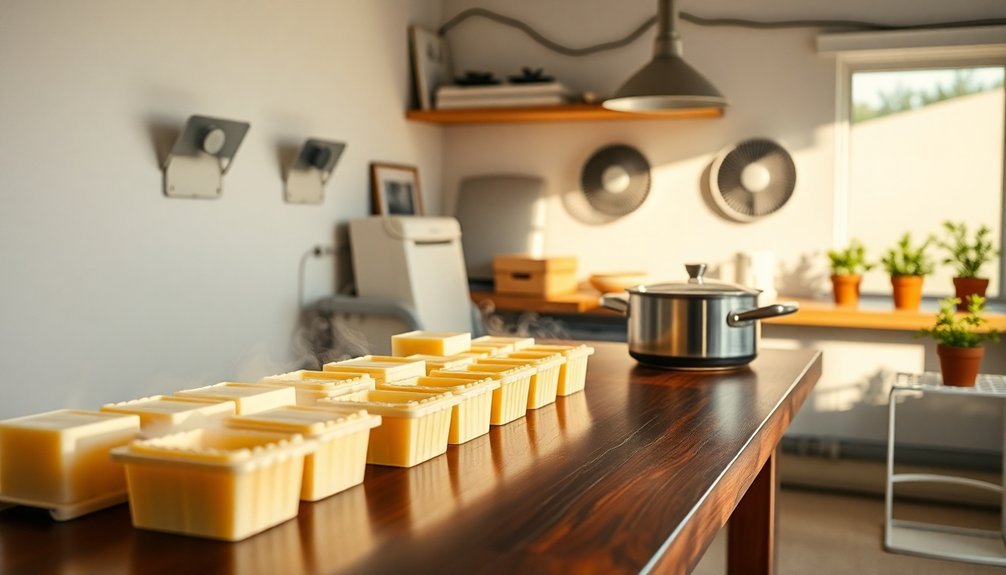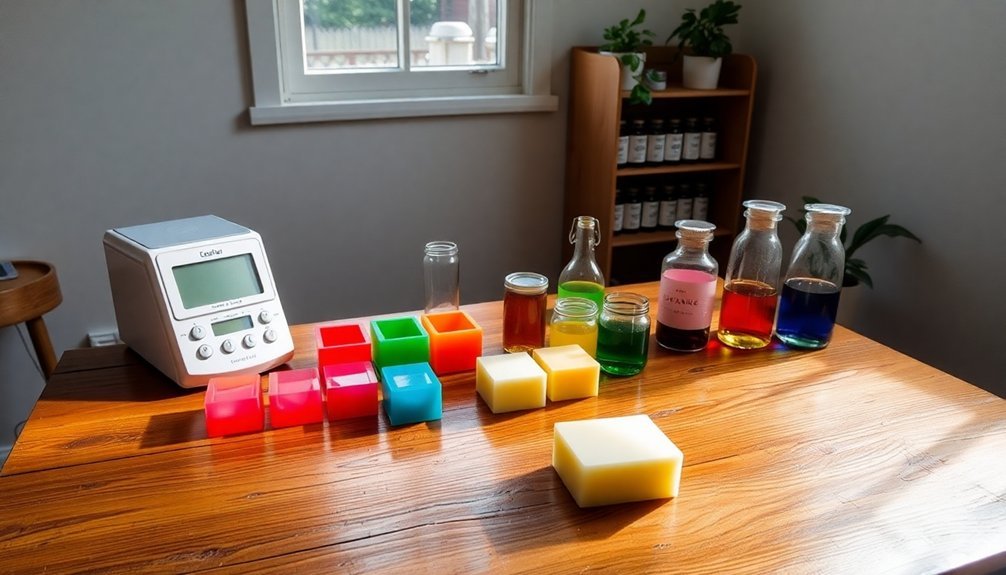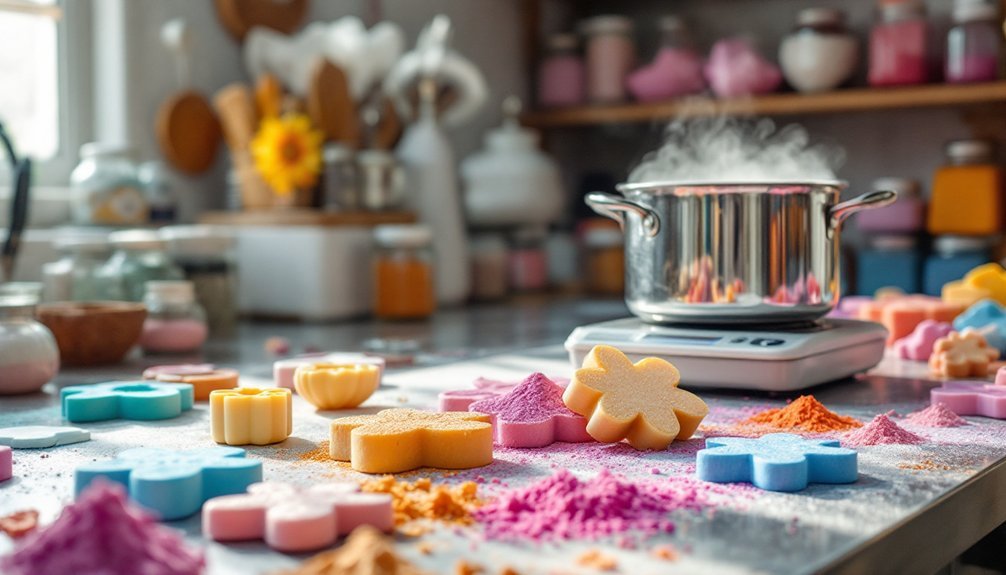To conquer tricky soap making environments, reduce water content in recipes for humid conditions and use a dehumidifier to maintain 45-55% humidity. Control temperatures between 100-130°F depending on desired results. Guarantee proper ventilation near windows or with fans to disperse lye fumes. Use filtered water and quality ingredients to avoid contaminants. Create a dedicated workspace with good lighting, sturdy surfaces, and vertical storage. These adjustments will transform your soap making experience from frustrating to flawless.
Conquering High Humidity Challenges in Soap Making

While many soap makers enjoy the craft year-round, high humidity presents unique obstacles that can frustrate even experienced artisans.
Soap making's joys can quickly dissolve when humidity strikes, challenging even the most skilled crafters.
When moisture saturates the air, your soap can't harden properly and may develop that dreaded "sweat" as glycerin draws atmospheric moisture to the surface.
To combat these issues, you'll need to extend curing time to at least 4-6 weeks and reduce water content in your recipes. Shipping across different climate zones can significantly increase the condensation risk during transit.
Set up a dehumidifier in your curing area to maintain ideal conditions between 45-55% humidity. Guarantee proper ventilation to prevent moisture from lingering around your bars.
Consider reformulating by minimizing humectant ingredients like honey, aloe vera, and salt.
For storage, wrap fully cured soaps in moisture-resistant packaging such as shrink wrap or closed cardboard containers.
Temperature Control Techniques for Perfect Curing
Because temperature greatly influences the entire soap-making process, mastering its control becomes essential for achieving perfectly cured bars. Aim to mix your lye and oils between 120°F and 130°F, keeping them within 10°F of each other for smooth saponification.
For complex designs, precise temperature management prevents acceleration and overheating issues. You'll find that cooler soaping (100-110°F) helps when using fresh ingredients like milk and prevents gel phase, while higher temperatures can enhance colors but may affect texture. The Heat Transfer Method can effectively melt hard oils and butters using the natural heat generated from lye water reactions.
During the 4-6 week curing period, maintain consistent temperature and humidity levels. Consider using a thermometer to monitor accuracy, and adjust your approach based on your desired outcome—whether you're seeking maximum hardness or vibrant colors through gel phase promotion.
Creating Optimal Ventilation for Soap Hardening

Proper ventilation serves as both a safety requirement and a quality factor in the soap making process. When mixing lye with water, you'll generate harmful fumes that require immediate dispersion. Set up your workspace near open windows or use exhaust fans to maintain consistent airflow.
For best results, consider taking your soap making outdoors where vapors dissipate naturally. If you're working indoors, make certain you're not in an enclosed space and run fans to prevent fume buildup. Always protect yourself with proper personal protective equipment while handling lye solutions, regardless of ventilation quality.
Keep your workspace clean and organized to minimize accidents that could generate additional vapors. Don't forget to allow adequate time for fumes to clear before returning to the area, and regularly check your ventilation system's effectiveness.
Good ventilation throughout all soap making phases guarantees both your safety and ideal hardening conditions.
Protecting Soap From Environmental Contaminants
Environmental contaminants can greatly degrade your soap's quality and safety if left unchecked. Pay attention to water quality, as tap water might contain heavy metals or chemicals that can compromise your soap. Consider using filtered or distilled water for best results.
Choose raw materials carefully, avoiding synthetic fragrances, parabens, and harsh surfactants that harm both your soap and the environment. Ask suppliers about their quality control processes to verify chemical-free ingredients. Be aware that some ingredients may contain PFAS chemicals which accumulate in water supplies and living tissue.
Be mindful of your ingredients—synthetic additives damage both your soap quality and our fragile ecosystem.
Store soap-making materials away from airborne pollutants and keep finished products in clean, sealed containers. Use biodegradable ingredients and eco-friendly packaging to minimize environmental impact.
During periods of increased soap usage, be especially vigilant about ingredient quality and water filtration. These simple precautions will protect your soap from common environmental contaminants while producing a safer, higher-quality product.
Setting Up an Ideal Workspace in Limited Conditions

Creating a functional soap-making workspace doesn't require a dedicated studio or expansive area. You can transform corners of your kitchen, basement, or garage into effective workstations with strategic planning.
Focus first on ventilation—open windows or install a small fan to disperse lye fumes safely. For lighting, portable LED lamps provide excellent visibility for precise measurements. Choose a sturdy, washable surface that's positioned away from household traffic to minimize distractions.
Maximize limited space with vertical storage solutions. Wall-mounted shelving keeps ingredients visible yet organized. Consider using clear containers for your supplies to quickly identify what you need without rummaging through opaque boxes. Create distinct zones for measuring, mixing, and curing, even if they're simply designated areas on the same table.
Always keep safety gear within arm's reach, and secure a locking cabinet for chemicals when not in use.
Frequently Asked Questions
How Do Seasonal Changes Affect Soap Recipe Formulations?
You'll need to adjust your soap recipes seasonally. In winter, add more nourishing oils for dry skin. During summer, focus on cleansing properties. Temperature and humidity will also affect curing times.
Can I Substitute Ingredients When Making Soap in Extreme Climates?
Yes, you can substitute ingredients with higher melting points like palm kernel flakes or beeswax in hot climates. In humid environments, you'll want less water-loving oils and more hard oils for faster curing.
What Safety Precautions Are Needed When Making Soap Outdoors?
When making soap outdoors, you'll need proper ventilation, weather-resistant equipment, eye protection, gloves, respiratory gear, and a clear spill plan. Always add lye to water and keep emergency supplies nearby.
How Does Altitude Impact Soap Making and Curing Times?
At higher altitudes, your soap will heat up faster during saponification and dry quicker during curing. You'll need to monitor temperatures carefully, use smaller batches, and adjust cure times through regular weight checks.
Are Certain Soap Mold Materials Better for Challenging Environments?
For challenging environments, you'll find silicone molds most reliable. They're durable across temperature extremes, require minimal maintenance, and won't degrade from essential oils like plastic does. Wooden molds need more care in humid conditions.
In Summary
You've now got five powerful tools to conquer even the trickiest soap making environments. Whether you're battling humidity, temperature fluctuations, poor ventilation, contaminants, or space limitations, these practical solutions will help you create perfect soap every time. Don't let challenging conditions stop your creativity—adapt your space, control your environment, and you'll soon be producing professional-quality soap regardless of where you're working.





Leave a Reply